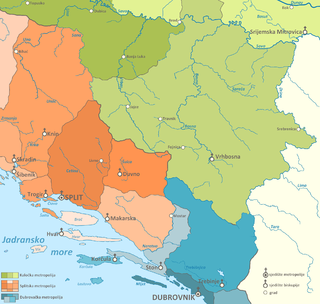Related Research Articles

The Archdiocese of Perugia-Città della Pieve is a Latin archdiocese of the Catholic Church. It was historically the Diocese of Perugia. It became the Archdiocese of Perugia in 1882, but without suffragans. It acquired suffragan dioceses in 1972. It was united in 1986 with the Diocese of Città della Pieve.
The Diocese of Trevico was a Roman Catholic diocese located in the town of Trevico in the province of Avellino, Campania, southern Italy. In 1818, it was suppressed to the Diocese of Lacedonia.
The Diocese of Isola was a Roman Catholic diocese in Italy, located in Isola di Capo Rizzuto, Crotone, Reggio Calabria in the ecclesiastical province of Santa Severina.

The Diocese of Ston was a Roman Catholic diocese in Croatia, located in the city of Stagno. In 1828 it was suppressed to the Archdiocese of Dubrovnik.
The Diocese of Levello was a Roman Catholic diocese in southern Italy, located in the city of Lavello, province of Potenza, in the region of Basilicata. In 1818, it was suppressed, and its territory and members incorporated in the Diocese of Venosa.
The Diocese of Bitetto was a Roman Catholic diocese in Italy, located in the town of Bitetto in the province of Bari, Apulia, Italy. In 1818, it was suppressed to the Diocese of Termoli.
The Roman Catholic Diocese of Capri was a Roman Catholic diocese located in the city of Capri on the island of Capri, in the Tyrrhenian Sea off the Sorrentine Peninsula, on the south side of the Gulf of Naples in the Campania region of Italy. On 27 June 1818, it was suppressed to the Archdiocese of Sorrento.
Giovanni Bernardino Grandopoli was a Roman Catholic prelate who served as Bishop of Lettere-Gragnano (1576–1590).
The Diocese of Vico Equense was a Roman Catholic diocese located in the coastal town of Vico Equense in the Metropolitan City of Naples, in Italy. It was suppressed in 1818 to the Archdiocese of Sorrento. It is now included in the Catholic Church's list of titular sees.
Giovanni Battista Ansaldo was a Roman Catholic prelate who served as Bishop of Cariati e Cerenzia (1576–1578).
Miguel Thomàs de Taxaquet was a Roman Catholic prelate who served as Bishop of Lérida (1577–1578).
Gaspare Viviani was a Roman Catholic prelate who served as Bishop of Anagni (1579–1605), Bishop of Hierapetra et Sitia (1571–1579), and Bishop of Sitia (1556–1571).
Alexander de Turre, C.R.L. was a Roman Catholic prelate who served as Bishop of Hierapetra et Sitia (1594–1624).
The Diocese of Sitia was a Roman Catholic diocese located in the city of Sitia on the island of Crete when it was under Venetian rule. On 16 July 1571, it was suppressed and united with the Diocese of Hierapetra to form the Diocese of Hierapetra et Sitia.
The Diocese of Torcello or Diocese of Turris was a Roman Catholic diocese located in the town of Torcello in the province of Venice in northeastern Italy. In 1818, it was suppressed to the Patriarchate of Venice.
The Diocese of Ravello e Scala was a Roman Catholic diocese located in the town of Ravello on the Amalfi Coast in the province of Salerno, Campania, southern Italy. In 1818, it was suppressed.
Cristóforo Chrisostome Carletti was a Roman Catholic prelate who served as Auxiliary Bishop of Calahorra y La Calzada (1624–1634) and Bishop of Termia (1622–1627).
The Diocese of San Leone was a Latin Church ecclesiastical jurisdiction or diocese of the Catholic Church located in the Italian town of San Leone in Calabria. In 1547, it was suppressed to the Archdiocese of Trani. It was restored as a titular see in 1966.
The Diocese of Caorle or Diocese of Calina was a Roman Catholic ecclesiastical territory in the town of Carinola in the Province of Caserta in the Italian region Campania. It was suppressed in 1818 to the Diocese of Sessa Aurunca.
The Diocese of Milos or Diocese of Melos was a Roman Catholic diocese located on the volcanic Greek island of Milos in the Aegean Sea, just north of the Sea of Crete. In 1700, it was suppressed. In 1800 it was restored as a Titular Episcopal See.
References
- ↑ "Diocese of Hierapetra et Sitia" Catholic-Hierarchy.org . David M. Cheney. Retrieved March 31, 2016
- 1 2 3 4 "Titular Episcopal See of Hierapytna”’’GCatholic.org’’. Gabriel Chow. Retrieved March 31, 2016
- ↑ "Bishop Gaspare Viviani" Catholic-Hierarchy.org . David M. Cheney. Retrieved March 21, 2016
- ↑ "Bishop Alexander de Turre, C.R.L." Catholic-Hierarchy.org . David M. Cheney. Retrieved March 21, 2016